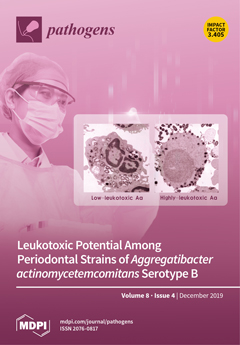Testing drinking water systems for the presence of
Legionella colonization is a proactive approach to assess and reduce the risk of Legionnaires’ disease. Previous studies suggest that there may be a link between
Legionella positivity in the hot water return line or certain
[...] Read more.
Testing drinking water systems for the presence of
Legionella colonization is a proactive approach to assess and reduce the risk of Legionnaires’ disease. Previous studies suggest that there may be a link between
Legionella positivity in the hot water return line or certain water quality parameters (temperature, free chlorine residual, etc.) with distal site
Legionella positivity. It has been suggested that these measurements could be used as a surrogate for testing for
Legionella in building water systems. We evaluated the relationship between hot water return line
Legionella positivity and other water quality parameters and
Legionella colonization in premise plumbing systems by testing 269 samples from domestic cold and hot water samples in 28 buildings. The hot water return line
Legionella positivity and distal site positivity only demonstrated a 77.8% concordance rate. Hot water return line
Legionella positivity compared to distal site positivity had a sensitivity of 55% and a specificity of 96%. There was poor correlation and a low positive predictive value between the hot water return line and distal outlet positivity. There was no correlation between
Legionella distal site positivity and total bacteria (heterotrophic plate count), pH, free chlorine, calcium, magnesium, zinc, manganese, copper, temperature, total organic carbon, or incoming cold-water chlorine concentration. These findings suggest that hot water return line
Legionella positivity and other water quality parameters are not predictive of distal site positivity and should not be used alone to determine the building’s
Legionella colonization rate and effectiveness of water management programs.
Full article






